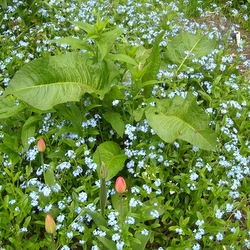Can you help us and identify this plant please?
Posted by Fiona Nevile in Flowers, General care | 17 comments“Did you know that you’ve got a giant dock weed growing in the herbaceous border?”
“Well yes and no. I thought it might be a dock at first but its leaves are larger and curly.”
Danny picked a regular dock leaf and compared them. Same colour, similar veins. The dock leaf was much smaller, without the grandiose frills.
I nipped inside and searched online for a plant with dock like leaves and found several possibilities but I would really like to know exactly what this plant is.
It needs to be moved as it is dominating a newly planted bush rose. It clearly is a relation of the dock family, some kind of sport perhaps?
This is the first time that Danny and I have had an active discussion over a plant – rather than the ‘those tulips are so pretty’ sort of clucks.
Danny loves our garden but isn’t interested in gardening per se. That is fine with me as it means that I can do whatever I like with the garden. But we are planning to start our “cut your own flowers” in a few weeks time.
“You must find out what the plant is before then,” Danny urged. “If it is a flowering plant you can say that it’s Novamerodockus Popularis – or whatever it’s called. Otherwise people will think it’s a giant weed.”
Now what garden doesn’t have weeds! I’m nurturing my dandelions to make wine again this year. At least that is what I’ve told Danny!
Leave a reply






I Believe it is dock ….leaves are high in iron and the seeds roared can be a coffee substitute
It seems to be to be edible Broad-leaved dock (Rumex obtusifolius).
I just read some of the earlier comments which I didn’t fully do before leaving mine.
Horseradish does indeed spread like wildfire.
From a foragers point of view it is good sense to leave some roots in place to regrow next year but maybe in this case it would be better lifted and grown on in a pot or in some quieter corner of the garden.
Oh, and if you are sure it’s horseradish, I saw several times interesting recipes with grilled/baked fish wrapped in horseradish leaves!
They are also added to fermented cucumbers (Polish way), but I don’t suppose you make those…
I am a bit late here, but thought at once: horseradish! I heard people grow horseradish in huge containers deep in the ground, otherwise the plant attacks the whole garden in no time at all…
It could indeed be horseradish.
Smell is the key for me.
The root is obviously the most potent part (as anyone who has ever grated one for sauce will tell you) but the leaf fronds also exude a very distinctive, if fainter, smell.
Hard to describe but have a smell of a jar of commercially made horseradish sauce and you’ll get the idea.
Then cut a leaf off and have a whiff.
If it is a horseradish root remember not to dig it all up and it should return year after year.
… and just re-read and had another thought:
“Danny picked a regular dock leaf and compared them. Same colour, similar veins. The dock leaf was much smaller, without the grandiose frills.”
sometimes plants damaged by a virus produce ellaborate growth caused by overactive cell division – it’s called ‘fasciation’ and results in waht appear to be mutant versions of the normal plant.
Celia
x
PS Thanks for the seeds – and the card is fab!!!!